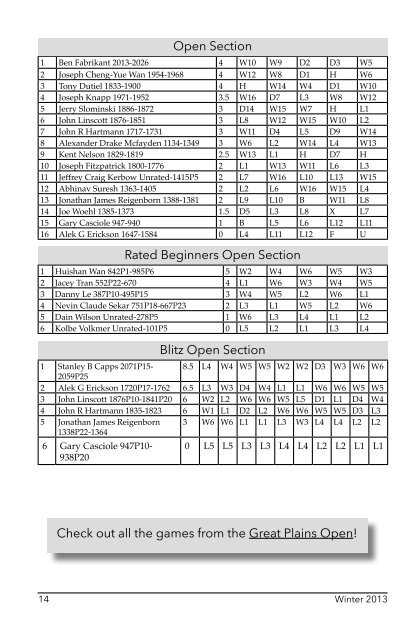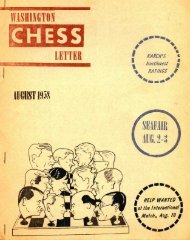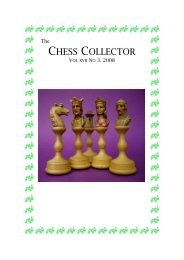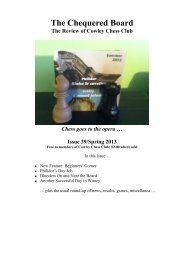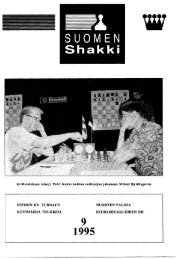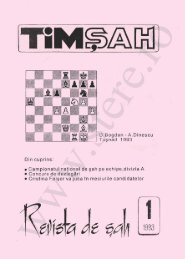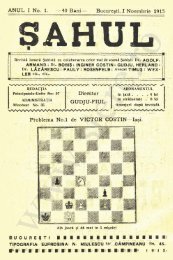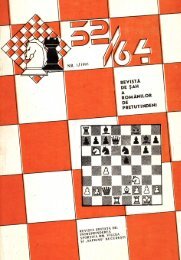The Gambit
El ajedrez es un juego, considerado un deporte, entre dos personas, cada una de las cuales dispone de 16 piezas móviles que se colocan sobre un tablero dividido en 64 escaques. En su versión de competición está considerado como un deporte.
El ajedrez es un juego, considerado un deporte, entre dos personas, cada una de las cuales dispone de 16 piezas móviles que se colocan sobre un tablero dividido en 64 escaques. En su versión de competición está considerado como un deporte.
Create successful ePaper yourself
Turn your PDF publications into a flip-book with our unique Google optimized e-Paper software.
Open Section<br />
1 Ben Fabrikant 2013-2026 4 W10 W9 D2 D3 W5<br />
2 Joseph Cheng-Yue Wan 1954-1968 4 W12 W8 D1 H W6<br />
3 Tony Dutiel 1833-1900 4 H W14 W4 D1 W10<br />
4 Joseph Knapp 1971-1952 3.5 W16 D7 L3 W8 W12<br />
5 Jerry Slominski 1886-1872 3 D14 W15 W7 H L1<br />
6 John Linscott 1876-1851 3 L8 W12 W15 W10 L2<br />
7 John R Hartmann 1717-1731 3 W11 D4 L5 D9 W14<br />
8 Alexander Drake Mcfayden 1134-1349 3 W6 L2 W14 L4 W13<br />
9 Kent Nelson 1829-1819 2.5 W13 L1 H D7 H<br />
10 Joseph Fitzpatrick 1800-1776 2 L1 W13 W11 L6 L3<br />
11 Jeffrey Craig Kerbow Unrated-1415P5 2 L7 W16 L10 L13 W15<br />
12 Abhinav Suresh 1363-1405 2 L2 L6 W16 W15 L4<br />
13 Jonathan James Reigenborn 1388-1381 2 L9 L10 B W11 L8<br />
14 Joe Woehl 1385-1373 1.5 D5 L3 L8 X L7<br />
15 Gary Casciole 947-940 1 B L5 L6 L12 L11<br />
16 Alek G Erickson 1647-1584 0 L4 L11 L12 F U<br />
Rated Beginners Open Section<br />
1 Huishan Wan 842P1-985P6 5 W2 W4 W6 W5 W3<br />
2 Jacey Tran 552P22-670 4 L1 W6 W3 W4 W5<br />
3 Danny Le 387P10-495P15 3 W4 W5 L2 W6 L1<br />
4 Nevin Claude Sekar 751P18-667P23 2 L3 L1 W5 L2 W6<br />
5 Dain Wilson Unrated-278P5 1 W6 L3 L4 L1 L2<br />
6 Kolbe Volkmer Unrated-101P5 0 L5 L2 L1 L3 L4<br />
Blitz Open Section<br />
1 Stanley B Capps 2071P15- 8.5 L4 W4 W5 W5 W2 W2 D3 W3 W6 W6<br />
2059P25<br />
2 Alek G Erickson 1720P17-1762 6.5 L3 W3 D4 W4 L1 L1 W6 W6 W5 W5<br />
3 John Linscott 1876P10-1841P20 6 W2 L2 W6 W6 W5 L5 D1 L1 D4 W4<br />
4 John R Hartmann 1835-1823 6 W1 L1 D2 L2 W6 W6 W5 W5 D3 L3<br />
5 Jonathan James Reigenborn 3 W6 W6 L1 L1 L3 W3 L4 L4 L2 L2<br />
1338P22-1364<br />
6 Gary Casciole 947P10-<br />
938P20<br />
0 L5 L5 L3 L3 L4 L4 L2 L2 L1 L1<br />
Check out all the games from the Great Plains Open!<br />
Dutiel/1833 - Knapp/1971<br />
This round 3 game was crucial to<br />
Dutiel’s final standing as co-champion.<br />
His opponent was former 2009 and 2012<br />
Omaha city champion, Joe Knapp, a very<br />
tough player. Comments are by Dutiel.<br />
1.e4 c5 2.c3 Nf6 3.e5 Nd5 4.d4 Nc6<br />
4..cd 5. cd, d6 is more common here<br />
5.Nf3<br />
I cannot keep the pawn. So, I just develop<br />
normally and transpose into the main<br />
line.<br />
5...e6<br />
This move allows me to start a pawn<br />
roller which results in getting a protected<br />
pawn on d6 and a very cramped position<br />
for black. 5...cxd4 6. cd, e6 and now it’s<br />
equal.<br />
6.c4 Nc7<br />
( 6...Qa5+ 7.Bd2 Ndb4 8.dxc5 Bxc5 9.a3<br />
Qb6 ( 9...Bd4 10.Nxd4 Qxe5+ 11.Be3<br />
Nxd4 12.axb4 Nf5 13.Qd2 ) 10.axb4 Bxf2+<br />
11.Ke2 Nxb4 12.Nc3 Bc5 13.Ne4 Be7<br />
14.Bc3 O-O )<br />
7.d5 exd5 8.cxd5 Nb4 9.d6 Ne6 10.Nc3<br />
b6<br />
During the game, I was very happy to see<br />
this move. His plan is simply too slow. I<br />
felt he had to play ..f6 right away to try<br />
to undermine my pawn chain. Here is an<br />
example variation:<br />
(10...f6 11.Bc4 Nc6 12.Nb5 a6 13.Bxe6<br />
Qa5+ 14.Nc3 dxe6 15.exf6 gxf6 16.Nd2<br />
h5 17.Nde4 Bg7 ( 17...Kf7 ) 18.d7+ Bxd7<br />
19.Nd6+ Ke7 20.Nxb7 Qb4 21.Qd6+ Ke8<br />
22.Nxc5 Ne5 23.Ne4 )<br />
11.a3<br />
Forcing the knight to retreat to c6 due to<br />
Qa4 if he tries to defend the c7 square<br />
from a6.<br />
11...Nc6 12.Bc4<br />
Fritz suggests Nb5 here instead with<br />
the immediate threat of Bg5. I prefer<br />
my move as it doesn’t move the same<br />
piece again, and also targets the key c7<br />
defender.<br />
12...a6<br />
Again, too many pawn moves. I am<br />
developing more pieces every move.<br />
( 12...Bb7 13.Nb5 Rc8 14.Bxe6 dxe6<br />
15.Nc7+ Rxc7 16.dxc7 Qxc7 17.O-O )<br />
13.Nd5 b5<br />
Not reconizing the coming danger. He<br />
had to defend with 13...h6 here.<br />
(13...h6 14.Bd2 b5 ) ( 13...f6 14.exf6 gxf6<br />
15.Nc7+ Kf7 ( 15...Nxc7 16.Ng5 Bxd6 (<br />
16...fxg5 17.Qh5# ) 17.Qh5+ Kf8 18.Qf7#<br />
) 16.Nxa8 b5 17.Ba2 c4 18.Qd5 Bb7 19.Nc7<br />
Bxd6 20.Qxd6 ( 20.Qh5+ Ke7 21.Nd5+ Kf8<br />
22.Bh6+ Kg8 23.Qf5 ) 20...Qxc7 )<br />
14.Bg5<br />
Did you know you can<br />
click on a game header<br />
and view the game on<br />
the NSCA website?<br />
Now you do!<br />
14 Winter 2013 15<br />
Winter 2013


